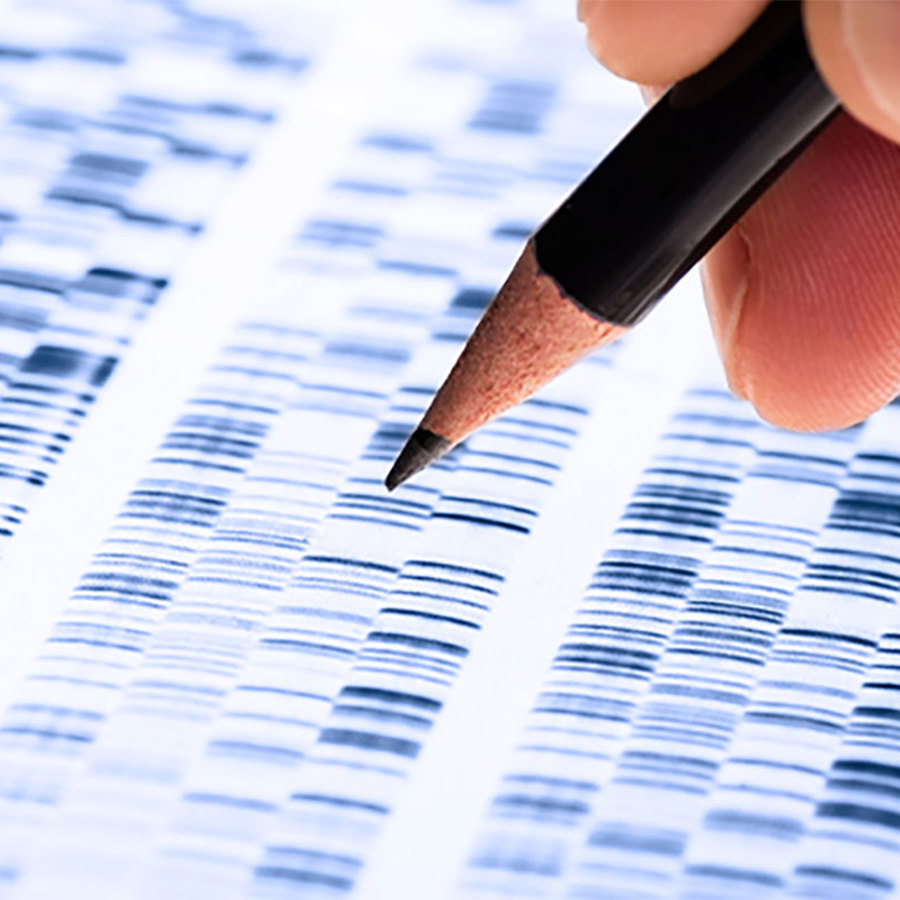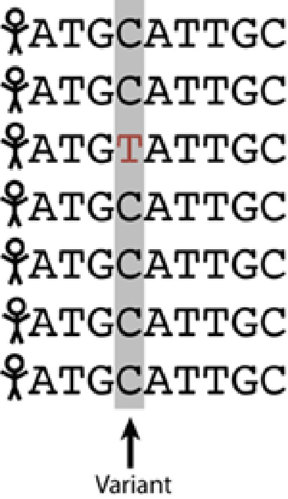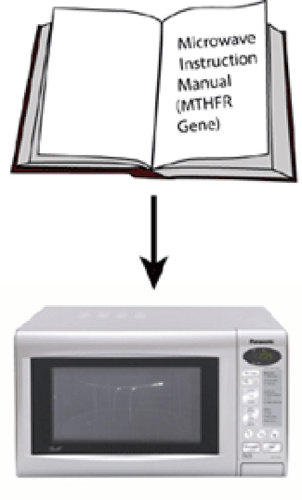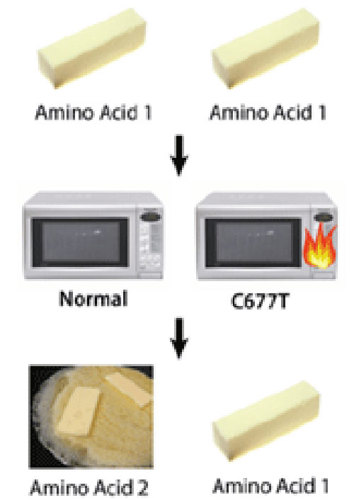
What are the A1298C and C677T mutations?
August 25, 2011

- Related Topics:
- Genetic variation,
- Population genetics
A curious adult from the U.S. military asks:
“What are the A1298C mutation and C677T mutation?”
Editor’s Note (2014):
Since we wrote this, scientists have found that these variants in the MTHFR gene may not be as worrisome as previously thought.
Given that these DNA differences are so common, it probably should come as no surprise that scientists are starting to rethink their effects on health. In fact, the American College of Medical Genetics and Genomics (ACMG) released a statement in early 2013 that in most cases there is not a medical reason to be tested for the C677T and A1298C variants of MTHFR.
The reason they came to this conclusion is that accumulating evidence seems to show no difference in risk for disease in people in the United States with and without the C677T and A1298C polymorphisms.1 In fact, the A1298C does not appear to affect the gene function at all. Keep in mind, though, that this is still an active area of research and none of this is definitive yet.
Good question! A1298C and C677T each refer to differences (or “variants”) in a gene in our DNA named MTHFR. Having one of these variants means that you have a slightly different version of the MTHFR gene.

A “variant” in a gene just means that the person has one letter different in their DNA. This is also sometimes called a “SNP” (single nucleotide polymorphism).
People talk about them because they can sometimes (but not always) cause health problems. For example, having one or both of them can put you at a higher risk for heart problems or having a child with birth defects. You could also be at a slightly increased risk for nerve defects and even schizophrenia.
But like I said, not everyone with these variants has problems. And this is a good thing, considering how common they are!
Around 30% of Europeans, 10% of Africans, and 40% of Japanese people have the C677T version of the MTHFR gene.1 The A1298C variant is even more common.
This all might sound scary – but not to worry. As I said before, most people that have these variants are perfectly fine, with no symptoms.
One reason is that to have a chance at ending up with problems, you need a double dose of these variants. Remember, you have two copies of each of your genes – one from your mom and one from your dad. So both the copy from mom and the copy from dad have to be the C677T and/or A1298C versions for there to be a risk for problems in this case.
Now the chance of having problems is much lower. For example, only around 10% of Europeans have two copies of the C677T version of the MTHFR gene.
Even if a person ends up with two copies of these different gene versions, it doesn’t mean that they will definitely have symptoms. For instance, a person with two copies of the C677T version of the gene has only a 10-20% higher chance of getting heart disease than someone with two non-C677T copies. And as far as scientists can tell, the A1298C version usually only causes problems if a person’s other gene copy is the C677T version.
So having two copies of C677T (or one copy of C677T and one copy of A1298C) really only increases the risks for certain problems. And sometimes, taking extra B vitamins can help to lower that risk. What I’ll do for the rest of the answer is talk about why these DNA differences can lead to such problems. To do this, though, we need to take a step back and talk about genes in general.
Genes and MTHFR
Our DNA is like a cookbook – it gives all the instructions for making us. Just like a cookbook has instructions for how to make bread and cookies, our DNA tells us how to make things like our hair and our eyes.
Our DNA cookbook is more thorough than a regular cookbook, though. It also gives the instructions for making all the tools that we need for cooking – like our pots, our pans, and our stove.

The recipes and instructions in our cookbook are called genes. The recipe for making chocolate chip cookies is in one recipe, or gene. The instruction manual for the microwave is in another.
Rather than explaining how to make cookies or how to put together a microwave, each gene explains how to make something that does some important job inside of our bodies. That something is called a protein.
The gene we’re talking about in this article gives the instructions for making a protein called methylenetetrahydrofolate reductase, or MTHFR. This protein is important for making sure that the right ingredients go into our recipes.
These ingredients are called amino acids, and they are the basic building blocks of every protein described by our genes. The job of the MTHFR protein is to help change one type of amino acid, or ingredient, into another one. (If you’re curious about which ones, MTHFR helps change the amino acid homocysteine into the amino acid methionine.)
You can think of the MTHFR protein like a microwave, which can turn solid butter into liquid butter. Both ingredients are used in lots of recipes. Some recipes, like cookies, need solid butter. Other recipes, like a cake, need melted butter. The microwave is important so that we can use either ingredient when we need them.
Small Change, Big Effect
Now let’s get back to the C677T and A1298C variants. Again, people with these variants have differences in the DNA of their MTHFR gene. In other words, they have different instructions for making their microwaves.
You can think of a gene with a variant as an instruction manual with one word changed. For example, the instructions for a microwave with a variant might read “put on the door with the handle facing inwards” instead of “handle facing outwards.”
So, different instructions can mean a microwave that works a bit differently. And that is why potential problems can arise.
The C677T variant is a change in the instruction manual that makes the MTHFR protein less able to deal with heat. The C677T version of the MTHFR protein is like a microwave with a glitch that causes it to sometimes spark and short-circuit if the weather gets too hot.
So, someone with the C677T variant has a MTHFR protein that doesn’t work all of the time because of the glitch. And so, they have a microwave that can't always do its important job of melting butter.

But as I said before, we have two copies of each set of instructions – one from mom, and one from dad. So fortunately, most people with this version of the MTHFR gene have another MTHFR gene, or set of microwave instructions, that is just fine. The other working microwave can take over to melt the solid butter when the C677T microwave can’t.
But problems can happen if both instruction manuals have the change. For example, a person with two faulty microwaves will be less able to make the important recipes with melted butter in them. Having too much solid butter lying around can also cause problems.
So, this is why having two C677T versions of the MTHFR gene can increase the chance of symptoms, like heart disease, that we mentioned before. But remember – not everyone with two C677T variants has symptoms. Some people manage just fine not being able to melt butter or having too much extra butter lying around.
And in fact, a person can deal with many of the symptoms of having two C677T variants by taking extra B vitamins. In a way, this is like using pre-melted butter, or maybe vegetable oil, to make the recipes needing melted butter. B vitamins can help the C677T version of the MTHFR protein do its job.
The second variant we mentioned, A1298C, has been studied a little bit less. It can cause problems too, although it seems that it only does when it comes along with the C677T variant. If one of the person’s instruction manuals has the C677T variant, and the person’s other manual has the A1298T variant, there isn't a fully working microwave to take over.
These two variants aren’t the only ones that have been found in people’s MTHFR genes, either. People have many other differences in their MTHFR instruction manuals. However, most of them probably don’t change the microwave that much. And since they are not as common, we don’t know as much about them.
There are lots of variants in the other genes of our DNA, too. These variants are what make us all unique! By studying them, scientists can better understand how all of our genes work together to make us who we are.
The Name Game
Want to understand what those complicated variant names (C677T and A1298C) mean? Instead of being made up of words like a recipe or instruction manual, our DNA is made up of the letters A, T, C and G.
A variant is often when one letter of a person’s DNA is different from most other people’s. Maybe they have a T in the place where most people have a C in their DNA. This difference at one letter is called a single nucleotide polymorphism, or SNP.
The first letter in the name of the variant is the original letter in the DNA. In the case of the C677T variant, it is the letter C. Can you guess what the T means? That's right – it is the letter found in the person with the variant, or the difference in their DNA.
And the numbers? Since a gene (and our DNA) is a string of letters, the numbers tell us where in the gene the variant is. For the C677T variant, the name tells us that the variant is at the 677th letter of the gene.
So, a person with the C677T variant has a T instead of a C at the 677th letter of the MTHFR gene in their DNA. Can you work out on your own what the A1298C mutation means?
Read More:
- Healthline: What You Need to Know About the MTHFR Gene
- MedlinePlus: MTHFR Mutation Test
- 23andMe’s take on the MTHFR gene

Author: Julie Granka
When this answer was published in 2011, Julie was a Ph.D. candidate in the Department of Biology, studying inferring historical processes from genetic data in Marc Feldman’s laboratory. Julie wrote this answer while participating in the Stanford at The Tech program.
 Skip Navigation
Skip Navigation
